Preventing Your Pipes from Cold Weather: Effective Methods
Preventing Your Pipes from Cold Weather: Effective Methods
Blog Article
Everyone seems to have their own individual piece of advice when it comes to 6 Ways to Prevent Frozen Pipes.

Cold weather can ruin your plumbing, particularly by freezing pipelines. Here's how to stop it from taking place and what to do if it does.
Introduction
As temperature levels drop, the danger of icy pipes boosts, possibly causing pricey repair work and water damage. Comprehending exactly how to avoid icy pipelines is crucial for home owners in cool climates.
Prevention Tips
Insulating vulnerable pipelines
Wrap pipelines in insulation sleeves or make use of heat tape to safeguard them from freezing temperature levels. Concentrate on pipes in unheated or external areas of the home.
Home heating methods
Maintain indoor spaces sufficiently heated up, specifically areas with plumbing. Open up cabinet doors to permit cozy air to circulate around pipes under sinks.
Exactly how to recognize icy pipes
Try to find lowered water flow from taps, uncommon smells or noises from pipelines, and noticeable frost on revealed pipelines.
Long-Term Solutions
Structural changes
Think about rerouting pipelines far from outside wall surfaces or unheated areas. Include extra insulation to attic rooms, basements, and crawl spaces.
Upgrading insulation
Purchase premium insulation for pipes, attics, and wall surfaces. Appropriate insulation assists maintain constant temperature levels and reduces the danger of frozen pipes.
Shielding Exterior Plumbing
Garden hose pipes and outside taps
Separate and drain pipes garden hoses prior to winter. Set up frost-proof faucets or cover exterior faucets with protected caps.
Recognizing Icy Pipes
What causes pipes to ice up?
Pipelines ice up when revealed to temperatures below 32 ° F (0 ° C) for extended periods. As water inside the pipelines freezes, it expands, taxing the pipe walls and possibly causing them to burst.
Dangers and problems
Frozen pipelines can lead to supply of water disruptions, property damage, and expensive repair services. Burst pipes can flood homes and create considerable structural damages.
Signs of Frozen Pipeline
Determining frozen pipes early can stop them from rupturing.
What to Do If Your Pipes Freeze
Immediate activities to take
If you presume frozen pipelines, maintain faucets open up to eliminate pressure as the ice thaws. Utilize a hairdryer or towels taken in hot water to thaw pipelines slowly.
Verdict
Stopping frozen pipes calls for positive actions and quick feedbacks. By comprehending the reasons, signs, and preventive measures, home owners can safeguard their pipes throughout winter.
5 Ways to Prevent Frozen Pipes
Drain Outdoor Faucets and Disconnect Hoses
First, close the shut-off valve that controls the flow of water in the pipe to your outdoor faucet. Then, head outside to disconnect and drain your hose and open the outdoor faucet to allow the water to completely drain out of the line. Turn off the faucet when done. Finally, head back to the shut-off valve and drain the remaining water inside the pipe into a bucket or container. Additionally, if you have a home irrigation system, you should consider hiring an expert to clear the system of water each year.
Insulate Pipes
One of the best and most cost-effective methods for preventing frozen water pipes is to wrap your pipes with insulation. This is especially important for areas in your home that aren’t exposed to heat, such as an attic. We suggest using foam sleeves, which can typically be found at your local hardware store.
Keep Heat Running at 65
Your pipes are located inside your walls, and the temperature there is much colder than the rest of the house. To prevent your pipes from freezing, The Insurance Information Institute suggests that you keep your home heated to at least 65 degrees, even when traveling. You may want to invest in smart devices that can keep an eye on the temperature in your home while you’re away.
Leave Water Dripping
Moving water — even a small trickle — can prevent ice from forming inside your pipes. When freezing temps are imminent, start a drip of water from all faucets that serve exposed pipes. Leaving a few faucets running will also help relieve pressure inside the pipes and help prevent a rupture if the water inside freezes.
Open Cupboard Doors
Warm your kitchen and bathroom pipes by opening cupboards and vanities. You should also leave your interior doors ajar to help warm air circulate evenly throughout your home.

We were shown that article on How to Prevent Your Pipes From Freezing through a buddy on another web address. Enjoyed reading our blog posting? Please share it. Help other people discover it. I love reading our article about 6 Ways to Prevent Frozen Pipes.
Click Here Report this page